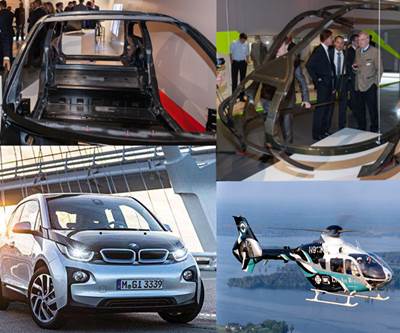Lilium celebrates maiden flight of CFRP air taxi
All-electric jet-powered, 5-seater uses composites to deliver performance.
Lilium (Munich, Germany) today revealed its new all-electric, five-seater air taxi prototype, the Lilium Jet, which completed its maiden flight in the skies over Germany earlier this month.
The structure of the Lilium Jet is nearly all carbon fiber-reinforced polymer (CFRP), the company says, a key component of the ultra-lightweight design. The full-scale, full-weight prototype is powered by 36 all-electric jet engines that reportedly enable it to take off and land vertically, while achieving efficient horizontal, or cruise, flight. The simple aircraft design — no tail, no rudder, no propellers, no gearbox and only one moving part in the engine — is said to contribute to the safety and affordability of the aircraft while also enabling the team to add aesthetic elements such as panoramic windows and gull-wing doors.
The aircraft reportedly can achieve a maximum speed of 300 kmh and a range of 300 kilometers. Its endurance is said to be due in part to an efficient, fixed wing design that generates enough lift to keep it in the air during cruise flight while using less than 10% of the aircraft’s 2000 horsepower. The aircraft is said to be an affordable, high-speed commuter option for connecting suburbs to city centers, airports to main train stations and travel between regions.
“Today we are taking another huge step towards making urban air mobility a reality,” says Daniel Wiegand, co-founder and CEO. “In less than two years, we have been able to design, build and successfully fly an aircraft that will serve as our template for mass production.”
The Lilium Jet’s first flight took place on May 4, after ground testing at the company’s headquarters in Munich, Germany. The prototype aircraft, which is controlled remotely from the ground, has since begun a flight test campaign to prove its capability and lay the foundations for certification of the aircraft to safety standards comparable to those of large commercial aircraft.
“Moving from two to five seats was always our ambition as it enables us to open up the skies to many more travelers,” Wiegand adds. “Whether it’s friends or families flying together or business travelers ride-sharing into the city, having five seats delivers an economy of scale you just can’t achieve with two. The Lilium Jet itself is beautiful and we were thrilled to see it take to the skies for the first time. With the perfect balance of range and speed, our aircraft has the potential to positively impact the way people choose to live and travel, all over the world.”
Lilium plans to manufacture and operate the Lilium Jet as part of its on-demand air taxi service. Lilium says carbon fiber composites have been in mind from the beginning and it is now planning for large-scale industrialization of its manufacturing processes. Passengers will be able to use the Lilium app to locate their nearest landing pad and plan their journey, and a network of taxi pads will be available across cities and regions. The aircraft is said to be comparable in price to a taxi but is four times faster.
Lilium expects to be fully-operational in various cities around the world by 2025, although trial services will start earlier than this in several locations.
The latest five-seater taxi builds on the successful flight testing of a two-seater prototype in 2017. The two-seater prototype provided proof of concept for Lilium’s signature transition flight maneuver, where the aircraft shifts from vertical to horizontal flight, and laid the groundwork for today’s prototype.
See the Lilium Jet in action and learn more in this video.
Related Content
National Composites Week 2025: Transportation
Commemorating the theme “Performance With Purpose,” CW has gathered key stories over the last year that exemplify how composites have progressed commercial automotive and mass transit.
Read MoreAward-winning Oder river bridge cuts 500 tons of steel with CFRP tension cables
Developed by Carbo-Link and tested by Empa, the Oder Bridge near Küstrin is a heavy rail bridge using 88 CFRP tension members, enabling 120 km/hr train speeds with reduced weight and emissions.
Read MoreHexagon Digital Wave provides requalification services for oilfield service company’s gas transportation fleet
Noninvasive modal acoustic emission (MAE) technology will support composite cylinder inspection for the U.S. company’s virtual pipeline trailers through 2027.
Read MoreNew Flyer selects Hexagon Purus H2 tanks for fifth consecutive year
Type 4 tanks will continue to be supplied for the mass mobility provider’s Xcelsior Charge FC fuel cell electric transit buses.
Read MoreRead Next
Carbon fiber will enable air taxi eVTOLs
Aircraft and autos have indeed faced CFRP production woes, but new tech opens door for both.
Read MoreNext-gen fan blades: Hybrid twin RTM, printed sensors, laser shock disassembly
MORPHO project demonstrates blade with 20% faster RTM cure cycle, uses AI-based monitoring for improved maintenance/life cycle management and proves laser shock disassembly for recycling.
Read MoreScaling up, optimizing the flax fiber composite camper
Greenlander’s Sherpa RV cab, which is largely constructed from flax fiber/bio-epoxy sandwich panels, nears commercial production readiness and next-generation scale-up.
Read More
.jpg;width=70;height=70;mode=crop)
.jpg;width=700;quality=80)
.jpg;width=860)

























